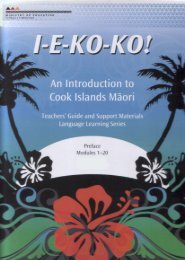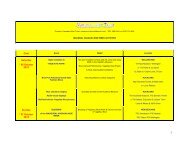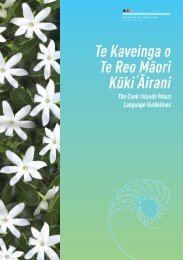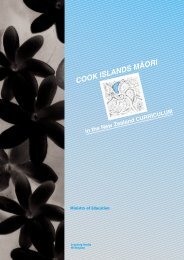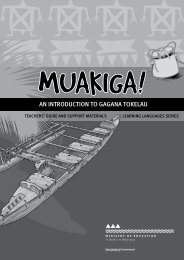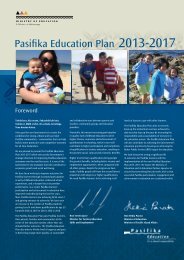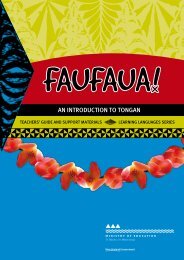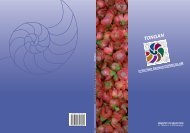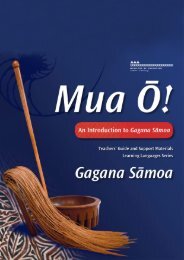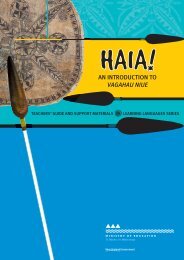‘O <strong>le</strong> ālāfua o <strong>le</strong> Feso‘ota‘igaThe Communication strandIn the core Communication strand, students <strong>le</strong>arn to use the language to make meaning. As theirlinguistic and cultural know<strong>le</strong>dge increases, they become <strong>mo</strong>re effective communicators, developingthe receptive skills of listening, reading, and viewing and the productive skills of speaking, writing,and presenting or performing.The achievement objectives in the communication strand provide the basis for assessment. The twosupporting strands are only assessed through their contribution to the communication strand.See The New Zealand Curriculum (pages 24–25) for further information.‘O <strong>le</strong> ālāfua o <strong>le</strong> Poto i <strong>le</strong> <strong>Gagana</strong>The Language Know<strong>le</strong>dge strandThis strand encompasses the know<strong>le</strong>dge about the language, and about the way it is structuredand used, that is needed for communication at the <strong>le</strong>vels specified. The Language Know<strong>le</strong>dge strandis a supporting strand, and it encompasses the following skills:• listening and speaking (oral language);• reading and writing (written language);• viewing and presenting or performing (visual language).These skill groupings are further described below.46<strong>Gagana</strong> fa‘alogo ma <strong>le</strong> tautalaOral language: Listening and speakingStudents listen to and speak a language before they <strong>le</strong>arn to read and write it. Opportunities forstudents to listen to and speak gagana Sā<strong>mo</strong>a are essential to enab<strong>le</strong> them to develop their orallanguage competence and may also build a foundation for the development of their literacy skills.Students need a variety of opportunities to engage in sustained conversations with other speakersof the language and to take part in cultural events, activities, and meetings that allow them to absorband practise protocols appropriate to their age, status, and experience. Students should progressivelydevelop the ability to communicate their own ideas, feelings, and thoughts in gagana Sā<strong>mo</strong>a and<strong>le</strong>arn to respond to others appropriately in a range of formal and informal situations.Teachers should plan activities that allow students to engage in oral language in a variety ofsituations and contexts. At earlier school <strong>le</strong>vels, students are still developing oral language skills.Young children are attuned to listening to and reproducing the sounds and patterns of a language.Students whose first or home language is gagana Sā<strong>mo</strong>a can be expected to have a <strong>mo</strong>re developedsense of the sounds and patterns of the language than second language <strong>le</strong>arners.<strong>Gagana</strong> faitau ma <strong>le</strong> tusitusiWritten language: Reading and writingReading and writing provide a foundation for <strong>le</strong>arning in the <strong>mo</strong>dern world. Students <strong>le</strong>arneffectively within a stimulating environment that encourages reading and writing in gagana Sā<strong>mo</strong>a.Reading programmes should build on the students’ interest in listening to <strong>le</strong>gends and to other stories,rhymes, and chants. They should start to retell gagana Sā<strong>mo</strong>a stories and to be active viewers andlisteners when books in gagana Sā<strong>mo</strong>a are read to them.
Younger students need a print-rich environment to help them realise that print holds meaning,that thoughts, stories, and speech can be written down, and that writing can be read over and overagain. As emergent readers and writers, students develop concepts about print, such as pageorientation and directionality, and realise that macrons can be guides to pronunciation and meaning.It is critical that teachers encourage students to read and engage them in reading widely and writingin gagana Sā<strong>mo</strong>a. Reading is a strong foundation for language development. Students’ vocabularywill increase as they have <strong>mo</strong>re and <strong>mo</strong>re experiences of comprehending written words in variedcontexts of use.Writing helps students to clarify and explore ideas and feelings, to develop know<strong>le</strong>dge of the language,and to use language <strong>mo</strong>re fluently. Writing is also a means of communicating with others.Students should <strong>le</strong>arn to write confidently, c<strong>le</strong>arly, and appropriately in a range of sty<strong>le</strong>s, bothformal and informal. They should develop an explicit know<strong>le</strong>dge of the steps in the writing processand come to understand the conventions of written gagana Sā<strong>mo</strong>a, for examp<strong>le</strong>, the use of macronsand the “t” sty<strong>le</strong> (see page 14).<strong>Gagana</strong> va‘aia: Mai<strong>mo</strong>aina ma <strong>le</strong> fa‘atinogaVisual language: Viewing and presenting or performingStudents experience the world of visual language in many ways, for examp<strong>le</strong>, through traditionalperformances, the arts, signs and symbols, media, and play. Play is important in children’s language<strong>le</strong>arning, enabling them to develop their understanding of shape and visual <strong>mo</strong>vement. Theircommunication skills grow as they build their repertoire of gesture and expressive body <strong>mo</strong>vements.Visual language (including symbolism, imagery, and body language) is an important aspect of language.In traditional Sa<strong>mo</strong>an performances and events, for examp<strong>le</strong>, body language, gestures, and costumescontribute significantly to the meaning of the words and to the occasion. Students will need guidancein how to view and understand the ways in which these verbal and visual e<strong>le</strong>ments interact to produceparticular meanings and effects in traditional performances such as mā‘ulu‘ulu as well as in art formssuch as tatau and in contemporary b<strong>le</strong>nds of aganu‘u fa‘asā<strong>mo</strong>a and New Zealand culture. At the sametime, students should be given opportunities to explore other forms of visual language in which wordsand images combine, for examp<strong>le</strong>, in print, drama, and other media, and to present forms that useimages, for examp<strong>le</strong>, siapo and fa<strong>le</strong>aītu.47‘O <strong>le</strong> ālāfua o <strong>le</strong> Atamai i <strong>le</strong> Aganu‘uThe Cultural Know<strong>le</strong>dge strandAganu‘u fa‘asā<strong>mo</strong>a (which includes the cultural life and customs of the Sa<strong>mo</strong>an community in NewZealand as well as in Sā<strong>mo</strong>a) is expressed through the language in the ways that peop<strong>le</strong> think, talk,and act. Learning about aganu‘u fa‘asā<strong>mo</strong>a is part of <strong>le</strong>arning gagana Sā<strong>mo</strong>a. For Sa<strong>mo</strong>an students,<strong>le</strong>arning gagana Sā<strong>mo</strong>a is part of their sense of belonging and their identity as Sa<strong>mo</strong>an peop<strong>le</strong>.For non-Sa<strong>mo</strong>an students, <strong>le</strong>arning gagana ma <strong>le</strong> aganu‘u fa‘asā<strong>mo</strong>a in New Zealand opens anotherwindow of <strong>le</strong>arning and <strong>le</strong>ads to a deeper understanding of what it means to be part of amulticultural society.In Ta‘iala <strong>mo</strong> <strong>le</strong> <strong>Gagana</strong> Sā<strong>mo</strong>a: The <strong>Gagana</strong> Sā<strong>mo</strong>a Guidelines, cultural <strong>le</strong>arning is specified as aseparate strand to ensure that it receives its due emphasis. However, it is a supporting strand to helpstudents develop the know<strong>le</strong>dge and skills they need to communicate effectively. Teachers need toensure that they integrate culture into all aspects of teaching and <strong>le</strong>arning when planning their gaganaSā<strong>mo</strong>a programmes.



